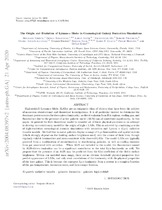The origin and evolution of Lyα blobs in cosmological galaxy formation simulations
Abstract
High-redshift Lyα blobs (LABs) are an enigmatic class of objects that have been the subject of numerous observational and theoretical investigations. It is of particular interest to determine the dominant power sources for their luminosity, as direct emission from H ii regions, cooling gas, and fluorescence due to the presence of active galactic nuclei (AGNs) can all contribute significantly. In this paper, we present the first theoretical model to consider all of these physical processes in an attempt to develop a model for the origin of LABs. This is achieved by combining a series of high-resolution cosmological zoom-in simulations with ionization and Lyα radiative transfer models. We find that massive galaxies display a range of Lyα luminosities and spatial extents (which strongly depend on the limiting surface brightness used) over the course of their lives, though regularly exhibit luminosities and sizes consistent with observed LABs. The model LABs are typically powered from a combination of recombination in star-forming galaxies, as well as cooling emission from gas associated with accretion. When AGNs are included in the model, the fluorescence caused by active galactic nucleus-driven ionization can be a significant contributor to the total Lyα luminosity as well. Within our modeled mass range, there are no obvious threshold physical properties that predict the appearance of LABs, and only weak correlations of the luminosity with the physical properties of the host galaxy.

